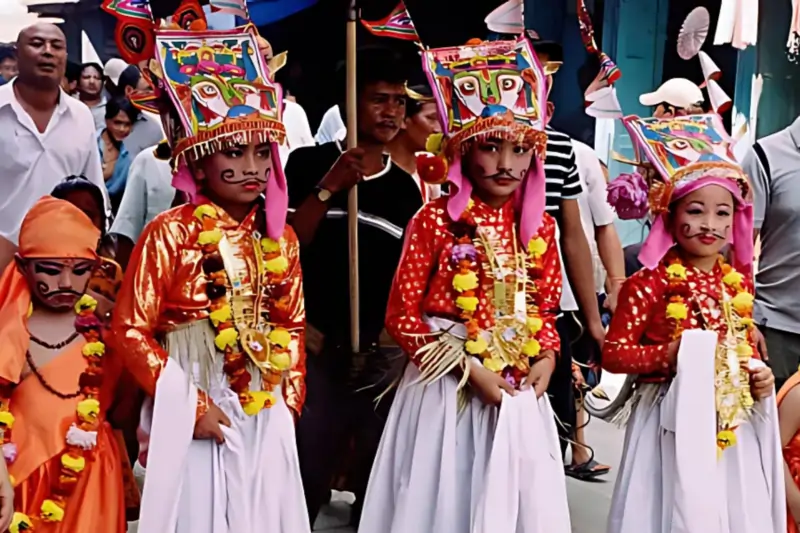Introduction to Gai Jatra
The festival of Gai Jatra is observed on the day following the full moon of the month of Shrawan. Traditionally, families who have lost loved ones in the past year participate in this festival by dressing up individuals to represent cows or decorating actual cows for a citywide procession. At various locations, these processions receive religious offerings and worship.
However, the term Gai Jatra carries a broader cultural and symbolic meaning. In Nepali tradition, cows are primarily worshiped on Laxmi Puja during Tihar. The rituals involving cows in Gai Jatra are not necessarily about revering the animal itself but are rooted in an ancient therapeutic tradition associated with mental well-being. The festival serves as a historical response to human psychological distress, including different forms of madness.
Gai Jatra and Its Connection to Mental Health
Ancient scholars attempted to understand the causes of madness using the Tridosha theory (a principle in Ayurveda). However, they were unable to categorize all forms of madness within this framework. The unexplainable cases were often attributed to supernatural forces, collectively termed as Bhootonmad (demonic madness). Among its various forms, one type associated with Gandharva-Graha (spirits of celestial musicians) is particularly relevant to Gai Jatra.
According to Ayurvedic texts, rituals involving cows, including sacrifices and worship, were performed to appease these celestial entities. Individuals afflicted by Gandharva-Graha were often characterized by behaviors such as singing, dancing, excessive laughter, and donning garlands in a state of euphoria. These characteristics are strikingly similar to the activities observed during Gai Jatra, processions filled with humor, satire, and theatrical performances.
The Cultural Role of Madness in Gai Jatra
The performances of exaggerated madness during Gai Jatra – singing, dancing, jesting, and humorous storytelling, align closely with traditional cultural practices. The festival provides a structured way for society to address grief, channeling it through communal expressions of joy and satire. It symbolizes an acceptance of death as a natural cycle and serves as a collective emotional healing process.
This association between ritualistic madness and cow worship suggests that Gai Jatra may have originally been a means to counteract supernatural afflictions. The fact that families mourning a lost one are the primary participants further reinforces the festival’s link to mental health and its therapeutic role in the community.
Historical Records and Speculations
Historical texts do not explicitly connect Gai Jatra to this tradition. The Gopal Banshawali, written about 500 years ago, only mentions the festival by name without detailing its origins. Some might find it difficult to accept this perspective, but the presence of similar rituals in other cultures suggests that ancient societies often adopted communal coping mechanisms in response to epidemics or psychological distress.
Today, we may not fully understand the phenomenon of Gandharva-Graha, but reports of mass hysteria-like events in certain parts of the world, such as the laughing epidemics in New Guinea, suggest that collective mental disturbances have existed across different civilizations. It is possible that, in ancient times, a similar mental affliction affected Kathmandu’s population, leading to the widespread adoption of cow-centered rituals as a form of relief.
This theory suggests that while Gai Jatra may have started as a ritual observed by specific bereaved families, it gradually expanded into an annual public event, perhaps in response to recurring pandemics or societal traumas. Even today, Nepalese society holds deep respect for traditions, and we see similar patterns of ritual responses, such as peace and prosperity prayers (Shanti Swasti Pooja) during outbreaks of diseases like cholera.
From Ritual to Celebration: The Evolution of Gai Jatra
Performances of madness inevitably bring laughter, and over time, what may have started as a solemn ritual transformed into a day of entertainment and satire. Historically, when communities gathered for agricultural or communal work, moments of joy and festivity were naturally incorporated into their lives. Over time, this cultural practice evolved into a day of amusement and freedom of expression.
Despite being associated with Buddhist traditions, where it is linked to the concept of Mara (a metaphor for desires and obstacles), Gai Jatra is primarily a celebration of humor and social critique. Events that begin as historical necessities often become embedded in folklore and evolve into myths. The act of questioning tradition requires careful cultural study rather than blind adherence to religious texts, legends, or genealogical records.
The coincidence of the Buddhist concept of Mara (defeat of illusions) with the day of Gai Jatra may have led to the belief that the festival is a Buddhist event. However, understanding the independent historical and cultural contexts of both events prevents misinterpretations.
The Legend Behind Gai Jatra
During the Malla era, a devastating smallpox epidemic swept through the Kathmandu Valley, claiming many lives. Among the deceased was the young prince. The queen, overwhelmed with grief, withdrew into sorrow, becoming increasingly frail despite the king’s efforts to console her.
After numerous failed attempts to uplift her spirit, the king and his ministers devised a plan to make her smile. They organized a festival where every family that had lost a loved one that year was required to participate. The tradition dictated that if a son had passed away, a family member would dress as an ascetic (jogi), and if a daughter had died, either a cow would be decorated, or someone would dress as one. Participants performed comedic acts, satire, and dances while parading through the streets.
The procession was required to pass in front of the royal palace. As the queen watched the festival from her balcony, she saw an endless parade of grieving families who had lost their loved ones, just like her. This realization that she was not alone in her suffering gradually lifted her spirits. The sight of humorous performances and vibrant costumes eventually made her smile and laugh.
From that moment, the tradition of Gai Jatra became an annual event, serving as both a commemoration of lost loved ones and a celebration of resilience through humor.
References
- Nepali Chad-Parbaharu Ko Bibechana, Mana Bajra Bajracharya, 1968

